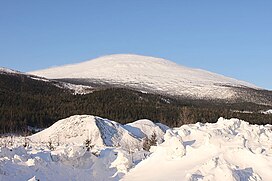| Kosvinsky Kamen | |
|---|---|
| Косвинский камень | |
 | |
| Highest point | |
| Elevation | 1,519 m (4,984 ft) |
| Coordinates | 59°31′N 59°03′E / 59.517°N 59.050°E |
| Geography | |
| Location | Russia |
| Parent range | Ural Mountains |
Mount Kosvinsky Kamen, Kosvinsky Mountain, Kosvinski Mountain,[1] Kosvinsky Rock or Rostesnoy Rock (Russian: Косвинский камень, Косьвинский камень, Ростесной камень) is a mountain in the northern Urals, Sverdlovsk Oblast, Russia.[2][3]
Its summit is bare of vegetation with an uneven rocky surface and small lakes fed by melting snow. The Kosva River flows from the mountain, hence the name.[3]
The Great Soviet Encyclopedia describes Kosvinsky Rock as "mountain massif" of height 1,519 m.[4] Its constitution is pyroxenites and dunites of lower and middle Paleozoic era. The slopes are covered with conifers with some birch up to 900–1,000 m, with alpine tundra above.[5]